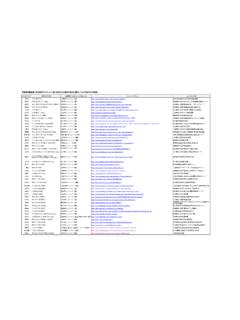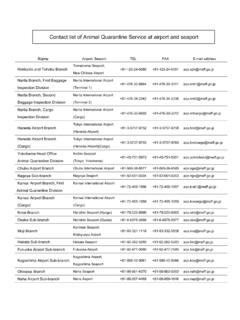Transcription of Handbook for Introduction of Food Traceability Systems
1 Handbook for Introduction of food Traceability Systems Guidelines for food Traceability ). March 2003 (First edition). March 2007 (Second edition). Revision Committee on the Handbook for Introduction of food Traceability Systems food Marketing Research and Information Center (FMRIC) 2008. Notes for English version All rights reserved. This English version was translated from the Japanese document (revised in March 2007) Handbook for Introduction of food Traceability Systems (Guidelines for food Traceability ). The translation was supervised by the Committee for Developing Educational Materials for food Traceability (Chairperson Yoko Niiyama, professor of Kyoto University) and was issued by the food Marketing Research and Information Center (FMRIC), with assistance from the Ministry of Agriculture, Forestry and Fisheries (MAFF). URL to obtain English version: URL to obtain original(Japanese version): food Marketing Research and Information Center (FMRIC).
2 Nogyo-Gijutsu-Kaikan Bldg, 1-26-3 Nishigahara Kita-ku Tokyo Japan E-mail: web Second print (March 2008). Table of Contents 1. 0-1 Background history on the original Handbook .. 1. 0-2 Revision of the guidelines: Background and 1. 0-3 Purpose of this Handbook .. 3. 0-4 Structure of this Handbook .. 4. 0-5 For the future .. 4. Part I. Fundamentals of food Traceability 5. 1. Scope of this Handbook .. 5. 1-1 Type of foods covered .. 5. 1-2 Type of industries covered .. 5. 2. Related laws and other 6. 2-1 Laws .. 6. 2-2 Standards, guidelines, etc. on food Traceability 11. 2-3 Standards related to food Traceability .. 11. 3. 13. 4. Introduction of food Traceability Systems : Objectives and important considerations .. 19. 4-1 Objectives .. 19. 4-2 Scope of Traceability system .. 20. 4-3 Important considerations .. 21. 5. Introduction of food Traceability Systems : Fundamentals .. 25. 5-1 food identification and 25. 5-1-1 Principles of identification and linkage.
3 25. 5-1-2 Organizing the flows of materials and information, and rules on identification and linkage .. 27. 5-1-3 Identification and linkage at each stage (Principles 3~6).. 31. 5-2 Recording information .. 36. 5-3 Storing 36. 5-4 Verifying the Traceability system .. 37. 5-5 Transmitting and disclosing information .. 39. 5-6 Designating and preserving necessary 41. Part II. How to introduce a food Traceability 42. 6. Introduction of a food Traceability system : The first stage .. 43. 6-1 Cooperation and coordination among operators, and ensuring consistency .. 43. 6-2 Assessment of the current 44. 6-3 Formulation of a basic plan .. 45. 7. Introduction of a food Traceability system : The second stage .. 49. 7-1 Preparing the system , clarifying roles and 49. 7-2 Drafting a plan for implementation .. 49. 7-3 Writing a Traceability procedural manual .. 50. 7-4 Establishing a schedule for Introduction of the system .. 50. 7-5 Training of relevant personnel.
4 50. 7-6 Important considerations in the creation of the electronic information Systems .. 51. 8. Important considerations after the Introduction of a Traceability system .. 53. 8-1 Publicity .. 53. 8-2 Improving and renewing the 53. 54. Appendix A: Indicating form of transmitting information and its storage media used in the food Traceability system .. 54. A-1 Indicating methods of transmitting information and its storage 54. A-2 Code Systems .. 57. 62. Committee members .. 64. Work Progress .. 67. Introduction 0-1 Background history on the original Handbook Historically the food industry has addressed the management of food hygiene, safety, and quality through the Introduction of HACCP and ISO9001, etc. However, when issues such as false labeling and occurrences of BSE became public, the food industry lost consumer trust in commercial food products. More and more consumers were demanding a food supply at which every stage of production, processing, and distribution of a food item could be documented, and tracked.
5 These demands included stricter solution of food safety compliance throughout the food industry. As a result, constructing a system for a reliable food Traceability system became urgent task. A food Traceability system enables to follow the movement of any food product by documentation of each point of food handling. When an incident occurs, the food Traceability system could efficiently assist in the recall of the food product(s) in question and assist in the investigation of the cause. Also transmitting and verifying the relevant information would contribute to increasing reliability on the information of the label and so on, and thus enables consumers to purchase food with a sense of security. Moreover, it is important to fully be aware that the Traceability system is simply a means for attaining that objective. And it is important not to fall into the excessive pursuit, such as making establishment of Traceability system itself as an objective.
6 Thus, with this as a background, in order to promote the construction of a food Traceability system and to set guidelines which would be a guide in introducing Traceability system , the Committee on the Handbook for Introduction of food Traceability Systems was established. A working group from within the Committee was formed to further study the available information on food Traceability . From an extensive review of the literature and the knowledge of actual experiments and outcomes from overseas, this Handbook for the Introduction of food Traceability Systems (hereon, mentioned as Handbook ) was completed and released on March of 2003. 0-2 Revision of the guidelines: Background and details With the release of this Handbook , the basic idea of food Traceability . became widely recognized within this country. The Handbook became the primary reference for producers and food business operators (hereon also referred to as 1.)
7 Operators ), organizations and industrial associations (hereon also referred to as organizations and associations ) made up of producers and food operators, and for information related business operators who support the Introduction of the food Traceability system . Furthermore, the Handbook provided the basic framework and core information utilized for writing guidelines for specific food products and specific industries. The Beef Traceability Law went into effect in June of 2003 and relevant government ministerial and ordinance were enacted for domestic cattle and beef. In addition to the domestic beef Traceability Introduction Handbook (general remarks version), handbooks for each stage of production were written. Other food products with written guidelines include fresh produce, eggs, shellfish (oysters and scallops), farmed fish, and laver. Guidelines for other food products are expected to be forthcoming. Requirements for food Traceability Systems was decided based on this Handbook as a standard to verify food Traceability system and was released in October of 2006.
8 Internationally, the definition of food Traceability was set at Codex Alimentarius Commission (June of 2004). Through the ISO, a draft on Traceability in the feed and food chain-General principles and basic requirements for system design and implementation (ISO/DIS 22005) is under discussion and close to completion. Requirements for food Traceability Systems have been written to meet all the requirements of this ISO/DIS22005 (as of November, 2005). After the Handbook was released, the food Traceability system became compulsory for cattle and beef within the country by law. As a result of the Introduction of this legislation and the Handbook , the food Traceability system has made rapid progress. Accurate and effective monitoring and maintaining of the quality of this system is expected in the future. For other food items, the Introduction of the Traceability system is not currently required but rather the responsibility of each food business operator.
9 In this atmosphere of voluntary compliance, ensuring Traceability within individual food businesses has steadily advanced. For example, keeping records of primary production stage during cultivation, breeding, and identification and linking of raw materials and products at the processing stage have become more common. The primary objective of the Handbook has been to ensure food Traceability throughout the food chain. Unfortunately, there are fewer participants than desired in the new food Traceability Systems through the food chain and dealing with this problem 2. remains a big task. In order to tackle this task, it will be necessary to maximize the consistency by having the participating food operators seek cooperation and adjustments among themselves. Also designing the Systems considering the costs and effects is necessary to make the Systems more appealing to prospective food operators. Based on these accomplishments and tasks in mind, the Handbook was revised so that it would be a more effective reference for food operators and their organizations and industrial associations.
10 Upon revision, the Committee on the Handbook for Introduction of food Traceability Systems (hereon referred to as committee ) was held and after the approval of the revision, the committee changed its name to Revision Committee on the Handbook for Introduction of food Traceability Systems and began discussions on this matter. 0-3 Purpose of this Handbook This Handbook is directed toward producers of primary production, food processors, distributors, retailers, restaurant and take-out food operators, information related companies, organization and industrial associations of prospective companies and individuals who plan to introduce Traceability system . The Handbook supports the Introduction of the Traceability system by including fundamentals, procedures, and so forth. For food operators and their organizations and industrial associations which already have introduced Traceability Systems , this Handbook provides guidelines that can help in conducting employee training, in reviewing the current system , in expanding the subject range of the Traceability system , and in realizing the system connections with other food operators.










